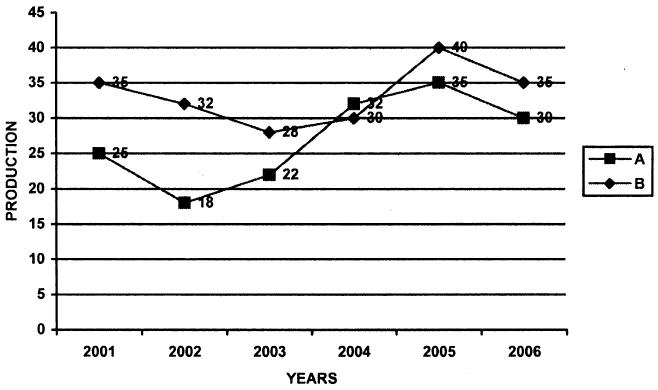1. The average of 20 numbers is 28. Later, it was pointed out that value of one the numbers was wrongly taken as 72 instead of 87.
What is the correct average?
1) 32 2) 25.5 3) 30.75
4) 31.25 5) None of these
2. A number when divided by 136 leaves a remainder 71. If the same number is divided by 17, then the remainder will be
1) 4 2) 18 3) 3 4) Can’t be determined 5) None of these
3. How many square tiles of 20cm length will be required to pave a footpath 1m wide built around the outside of a grass plot 32m long
and 16m wide?
1) 1200 2) 1800 3) 3200 4) 2500 5) 2400
4. In measuring the sides of a rectangle, one side is taken 10% in excess, and the other 5% in deficit. What is the change in its area
as a percentage?
1) 1.5% 2) 4.5% 3) 2.5% 4) 5% 5) None of theses
5. An amount of Rs.2730 is to be divided to three persons A, B and C such that 2 times of A’s share, 3 times of B’s share and 4 times
of C’s share are equal. Find the share of B?
1) Rs. 210 2) Rs. 1260 3) Rs. 840 4) Rs. 630 5) None of these
Directions (Q.6-10): Study the following graph carefully and answer the questions below that.
The following graph shows the production of wheat by two states A and B in various years. Production is in million tonnes
6. What is the average production of ‘B’ in all the years?
1) 22.3 million tonnes
2) 32.4 million tonnes
3) 28.7 million tonnes
4) 33.3 million tonnes
5) None of these
7. In which of the following years was the production of wheat of state ‘A’ same as the production of wheat of state ‘B’ in 2001?
1) 2003 2) 2006 3) 2002
4) 2005 5) None of these
8. In which of the following years was the increase/ decrease percent in the production of wheat of state ‘A’ the minimum comparing
to the previous year?
1) 2003 2) 2005 3) 2002
4) 2004 5) None of these
9. What is the decrement percent of the production of wheat of state ‘B’ in 2003 from 2002?
1) 15% 2) 14.2% 3) 12.5% 4) 7.5% 5) None of these
10. What is the difference in the production of state ‘A’ in 2002, 2005 together and production of State ‘B’ in 2003, 2005 together?
1) 10million tonnes 2) 18million tonnes
3) 13million tonnes 4) 27million tonnes 5) None of these
Directions (Q.11- 15): In each of the questions below, two equations
are provided. On the basis of these you have to find out the relation between P and Q.
Give answer 1) if P = Q or relationship can’t be established
Give answer 2) if P > Q
Give answer 3) if P < Q
Give answer 4) if P ≥ Q
Give answer 5) if P ≤ Q
11. P2 – P - 6 = 0 ;
Q2 – 3Q - 10 = 0
12. 2P2 – 3P + 5 = 3 + 2P2;
6Q – 7 = 3Q – 5
13. 4P2 – 23P +15 = 0 ;
2Q2 – 11Q + 5 = 0
14. 5P + Q = 11; P + 3Q = 5
15. P2 – 6P -16 = 0; Q2 – 6Q - 40 = 0
Directions (Q.16 - 18): Each of the following questions
below consists of a question and three statements A, B and C. You have to study the questions and the statements and decide whether the
question can be answered with any one or two or all of the statements
together.
16. What is the length of the tunnel?
A) Train crosses the tunnel in 40 sec.
B) The train, which is 450m long crosses a man in 30sec..
C) The speed of the train is 54kmph.
1) A and C 2) B and C 3) A and B 4) All the three
5) None of these
17. Find the age of the supervisor?
A) There are 5 workers and a supervisor in the company.
B) The average age of the workers is 24 years.
C) The average age increases by 2 years if the supervisor's age is also included.
1) only A 2) A and C 3) only B 4) All the three 5) None of these
18. What is the length of the rectangle?
A) Area of the square whose side is equal to the breadth of the rectangle is 144 sq m.
B) The length of the rectangle is 25% more than its breadth.
C) The breadth of the rectangle is 12m.
1) A and B 2) B and C 3) A and C
4) 1 or 2 5) Any two
ANSWERS:
1) 5 2) 3 3) 4 4) 2 5) 3 6) 4 7) 4 8) 2 9) 3 10) 1 11) 5 12) 1 13) 4
14) 2 15) 1 16) 3 17) 4 18) 4.
